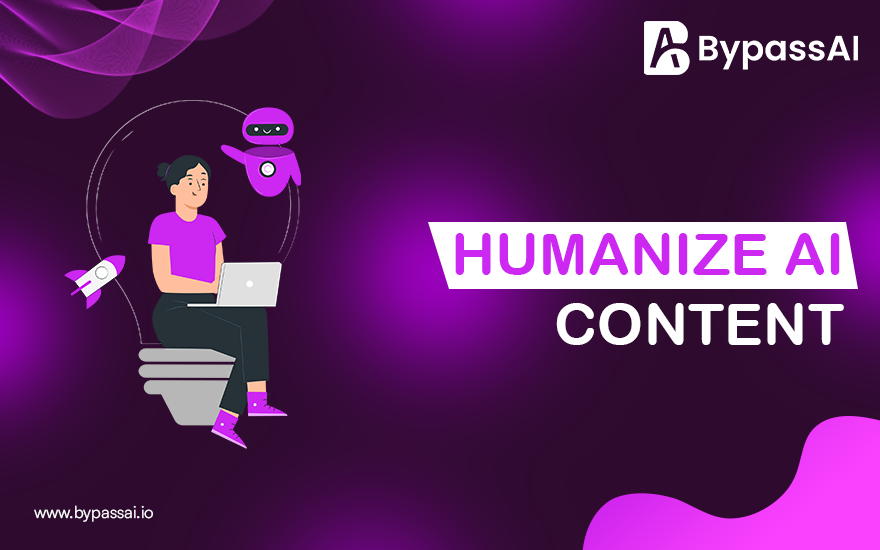7 Easy Ways to Humanize Your AI-Generated Content

In today’s fast-paced digital landscape, AI-generated content has become the backbone of many content strategies. While AI tools offer speed and scalability, their outputs often lack the emotional depth, tone, and relatability that resonate with human readers. To ensure your content doesn’t sound robotic and can bypass AI detectors, such as Google’s algorithms or educational plagiarism checkers, it’s crucial to humanize AI-generated text effectively. Below, we uncover 7 easy and powerful ways to Humanize AI generated content for better engagement, trust, and SEO performance.
1. Add Personal Anecdotes and Real-Life Examples
One of the clearest giveaways of AI-generated text is its lack of personal touch. To make your content feel real and relatable:
- Insert personal stories, relevant case studies, or relatable analogies.
- Mention first-hand experiences, either from your team or users.
- Use narrative writing that introduces a problem-solution format that people can connect with.
Example:
Instead of saying “Exercise improves mental health,” try:
“After switching to a 15-minute daily walk routine, our content team reported better focus and fewer burnout complaints.”
This approach instantly adds credibility and warmth.
2. Use Natural, Conversational Language
AI often produces overly formal or mechanical content. To mimic human tone:
- Use contractions like “you’re,” “we’re,” “can’t,” and “they’re.”
- Choose simpler synonyms – say “help” instead of “facilitate,” or “use” instead of “utilize.”
- Sprinkle in rhetorical questions to engage the reader: “Ever felt like your content just doesn’t sound right?”
This creates an inviting, readable flow that keeps users on your page longer – a critical SEO signal.
3. Break the Pattern with Sentence Variety and Pacing
AI-generated paragraphs often follow a monotonous rhythm – same sentence lengths, same structures. To break that up:
- Vary sentence lengths. Use a short, punchy line. Then, follow it with something a bit longer and more detailed.
- Add em-dashes, ellipses, and parentheses for expressive punctuation.
- Use sentence fragments when appropriate, for effect.
Example:
“Content fatigue is real. And AI is making it worse.”
This human-like cadence is difficult for AI to reproduce and easier for readers to digest.
4. Optimize for Emotion-Driven Language
Emotion is the bridge between content and human behavior. Incorporate emotional triggers to humanize your AI content:
- Use power words like “essential,” “irresistible,” “frustrating,” “amazing,” and “terrifying.”
- Create empathy by identifying readers’ pain points or aspirations:
“We know how exhausting it feels when your content still doesn’t perform after hours of work.”
Emotion-rich content encourages sharing, improves dwell time, and reduces bounce rates – key SEO metrics.
5. Incorporate Visual and Sensory Language
Humanized content activates the senses. When possible, paint a picture with your words:
- Include visual elements in descriptions: “Imagine walking into a room where every wall tells a story.”
- Mention sensory details: smells, textures, sounds.
- Use metaphor and simile: “Like a compass in a foggy sea, a human touch in content can guide the reader.”
This technique doesn’t just add flair – it boosts comprehension and memorability.
6. Use Strategic Formatting and Structure
Good human-written content is scannable. While AI often outputs large, dense blocks of text, humans break it up naturally:
- Use bullet points, numbered lists, and bold keywords.
- Insert clear subheadings with SEO-rich phrases.
- Add internal linking to your blogs or pages to keep users on-site longer.
Example:
Rather than saying:
“Many AI tools lack emotional resonance, tone flexibility, and contextual awareness.”
Say:
AI tools often fall short in:
- Emotional depth
- Tone adaptability
- Contextual accuracy
Clean formatting shows intentionality and reader empathy – hallmarks of human writing.
7. Run It Through BypassAI for the Final Polish
Even after all the manual touches, it’s smart to verify if your content passes as human. That’s where BypassAI shines.
- It uses advanced detection evasion to ensure your text beats AI detectors.
- The platform helps rewrite sentences to sound more natural while maintaining the message.
- Great for students, marketers, and bloggers who want to stay authentic and undetectable.
BypassAI isn’t just a tool – it’s your quality gatekeeper, especially if you rely heavily on tools like ChatGPT, Jasper, or Copy.ai.
Conclusion
With the rise of AI writing, the need to sound authentically human has never been more important. From improving your SEO rankings to winning audience trust, these seven easy methods will help you Humanize AI content so it not only bypasses AI detectors but also connects on a deeper level.
Don’t just rely on artificial intelligence – Humanize AI by infusing your content with real intention, empathy, and style. Your readers (and Google) will thank you.





